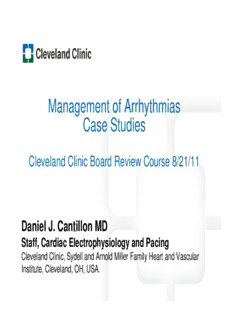
Management of Arrhythmias Case Studies PDF
Preview Management of Arrhythmias Case Studies
Management of Arrhythmias Case Studies Cleveland Clinic Board Review Course 8/21/11 Daniel J. Cantillon MD Staff, Cardiac Electrophysiology and Pacing Cleveland Clinic, Sydell and Arnold Miller Family Heart and Vascular Institute, Cleveland, OH, USA. Case #1 – 40 year old female – No significant past medical history – Two prior syncopal events: – 10 years ago: Getting out of bed at night to use the bathroom, preceded by dizziness/nausea, no trauma, only briefly unconscious – 3 years ago: Upon sight of blood when her friend fell off a treadmill while exercising together, preceeded by dizziness/nausea, no trauma, only briefly unconscious. – Now presents to emergency department with palpitations Case #1 – 40 year old female HPI: – Abrupt onset of palpitations while preparing a meal – Not relieved by lying down on the couch – Pulse taken by house guest (a plastic surgeon) and fixed at 150 bpm, no response to carotid massage. – Brought to emergency department for further evaluation Family history: Parents living, 2 siblings. Negative for sudden death. Admitting ECG Case #1 – 40 year old female • Normal physical examination • Normal RV and LV size / function by echo. No significant valvular abnormalities • No arrhythmia events overnight on inpatient telemetry What is your next step in management? A. Implantable cardioverter-defibrillator B. EP study and ICD if inducible for ventricular arrhythmias C. Genetic testing inherited channelopathy D. Cardiac MRI E. Tilt table testing F. Reassurance / Observation Case #1 – 40 year old female • Cardiac MRI: Normal heart. No evidence of ARVC. • Tilt table testing: – Supine BP 102/61 HR 75 – Phase I head-up tilt: 109/69 HR 117 – Tolerated 70 degrees for 13 minutes. Terminated due to patient symptoms of lightheadedness. BP 93/42 HR 115 – Nuclear data: Normal blood volume. Normal Hg/HCT. – Impression: Postural orthostatic tachycardia response (HR increase > 30 bpm), Abnormal diastolic blood pressure response at maximum tilt (drop > 10 mm Hg) Case #1 – 40 year old female • 24 Hour Telemetery with Taping – Minimum heart rate 53 bpm – Maximum heart rate 135 bpm – No sustained arrhythmias – Rare single VPCs – ~ 500 APCs, 10 brief non-sustained SVT runs (triplets) • Genetic testing Brugada, LQTS, CPMVT panel: No identified mutations What is your next step in management? A. Implantable cardioverter-defibrillator B. EP study and ICD if inducible for ventricular arrhythmias C. Genetic testing inherited channelopathy D. Cardiac MRI E. Tilt table testing F. Reassurance / Observation EP study Non-inducible for VT or VF using Michigan protocol (quadripule extra-stimuli, from RV apex and RV outflow tract)
Description: